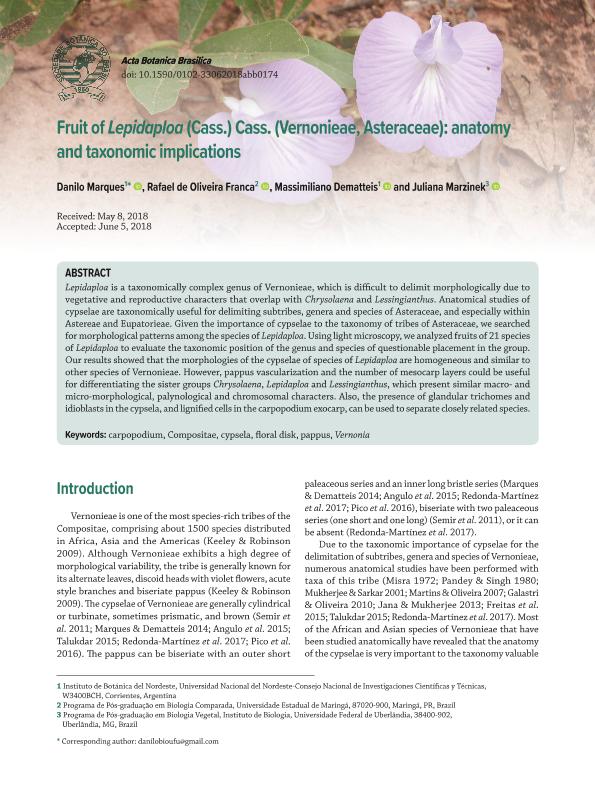Artículo
Fruit of lepidaploa (Cass.) cass. (vernonieae, asteraceae): Anatomy and taxonomic implications
Fecha de publicación:
10/2018
Editorial:
Sociedade Botanica do Brasil
Revista:
Acta Botanica Brasilica
ISSN:
0102-3306
e-ISSN:
1677-941X
Idioma:
Inglés
Tipo de recurso:
Artículo publicado
Clasificación temática:
Resumen
Lepidaploa is a taxonomically complex genus of Vernonieae, which is difficult to delimit morphologically due to vegetative and reproductive characters that overlap with Chrysolaena and Lessingianthus. Anatomical studies of cypselae are taxonomically useful for delimiting subtribes, genera and species of Asteraceae, and especially within Astereae and Eupatorieae. Given the importance of cypselae to the taxonomy of tribes of Asteraceae, we searched for morphological patterns among the species of Lepidaploa. Using light microscopy, we analyzed fruits of 21 species of Lepidaploa to evaluate the taxonomic position of the genus and species of questionable placement in the group. Our results showed that the morphologies of the cypselae of species of Lepidaploa are homogeneous and similar to other species of Vernonieae. However, pappus vascularization and the number of mesocarp layers could be useful for differentiating the sister groups Chrysolaena, Lepidaploa and Lessingianthus, which present similar macro-and micro-morphological, palynological and chromosomal characters. Also, the presence of glandular trichomes and idioblasts in the cypsela, and lignified cells in the carpopodium exocarp, can be used to separate closely related species.
Palabras clave:
CARPOPODIUM
,
COMPOSITAE
,
CYPSELA
,
FLORAL DISK
,
PAPPUS
,
VERNONIA
Archivos asociados
Licencia
Identificadores
Colecciones
Articulos(IBONE)
Articulos de INST.DE BOTANICA DEL NORDESTE (I)
Articulos de INST.DE BOTANICA DEL NORDESTE (I)
Citación
Marques, Danilo; Oliveira Franca, Rafael de; Dematteis, Massimiliano; Marzinek, Juliana; Fruit of lepidaploa (Cass.) cass. (vernonieae, asteraceae): Anatomy and taxonomic implications; Sociedade Botanica do Brasil; Acta Botanica Brasilica; 32; 4; 10-2018; 642-655
Compartir
Altmétricas




